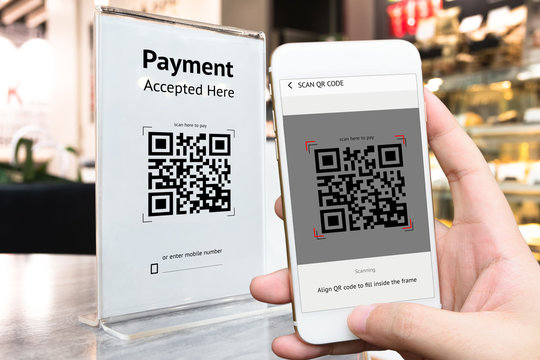Introduction
In today’s fast-paced world, convenience and efficiency are paramount in every aspect of our lives, including how we make payments. With the advent of technology, traditional payment methods are being revolutionized, and one such innovation leading the charge is QR code for payments. In this blog, we’ll explore how QR codes are reshaping the payment landscape overall globally, providing seamless and secure transaction experiences for both consumers and merchants.
Understanding QR Codes
Definition and Explanation
- QR codes, short form for Quick Response codes, are two-dimensional barcodes that contain information readable by a QR scanner or smartphone camera.
- They can encode various types of data, including text, URLs, contact information, and payment details.
How QR Codes Work in Payment Transactions
- Consumers scan a QR code displayed by the merchant using their smartphone camera or a dedicated QR code scanner app.
- The QR code contains payment information, such as the merchant’s account details and the transaction amount.
- The consumer confirms the payment, typically through a mobile payment app linked to their bank account or credit/debit card.
- The transaction is processed securely in real-time, and both parties receive instant confirmation.
Advantages of Using QR Codes for Payments
- Convenience: QR code payments offer a quick and hassle-free way to complete transactions, eliminating the need for physical cash or cards.
- Security: Unlike traditional payment methods that involve sharing sensitive information, QR code payments are encrypted and secure.
- Cost-effectiveness: QR code transactions often have lower processing fees for merchants compared to card-based payments.
The Rise of QR Code Payment Systems
Historical Background
- QR code payments originated in Japan in the 1990s and gained popularity in Asian countries before spreading globally used every where nowadays.
- They were initially used for inventory tracking and marketing purposes before being adopted for payment transactions.
Factors Contributing to Adoption
- The widespread use of smartphones equipped with QR code scanning capabilities and functionality.
- Convenience and speed offered by QR code payments, especially for small-value transactions.
- Support from businesses and financial institutions, driving the integration of QR code payment systems into their operations.
Examples of Industries and Countries
- Retail: QR code payments are increasingly prevalent in retail stores, restaurants, and cafes, offering customers a seamless checkout experience.
- Transportation: Public transportation systems in many countries have adopted QR code payments for ticketing, making travel more convenient for commuters.
- Emerging Markets: Countries like China and India have seen significant adoption of QR code payments, driven by the large smartphone user base and growing digital economy.
Benefits of QR Code Payments
Convenience
- Quick and Easy Transactions: With QR code payments, customers can complete transactions in seconds by simply scanning a code.
- No Need for Physical Cards: QR code payments eliminate the need to carry cash or multiple cards, streamlining the payment process.
Security
- Enhanced Safety Features: QR code payments utilize encryption and tokenization to protect sensitive payment information, reducing the risk of fraud.
- Reduced Exposure to Germs: In a post-pandemic world, contactless payment methods like QR codes minimize physical contact, promoting hygiene and safety.
Cost-effectiveness
- Lower Transaction Fees: Merchants often pay lower processing fees for QR code transactions compared to traditional card payments, leading to cost savings.
- Accessibility for Small Businesses: QR code payment solutions are affordable and accessible to small businesses, enabling them to accept digital payments without significant investment.
QR Code Payment Technologies
Types of QR Code Payment Technologies
- Static QR Codes: Fixed QR codes containing predefined payment information, suitable for merchants with a single payment account.
- Dynamic QR Codes: Dynamic QR codes generate unique payment information for each transaction, offering flexibility and enhanced security.
Comparison of Popular QR Code Payment Platforms
- Alipay: China’s leading mobile payment platform, offering QR code-based payment solutions and a wide range of financial services.
- WeChat Pay: Integrated within the WeChat messaging app, WeChat Pay enables users to make payments, transfer money, and more using QR codes.
- PayPal: The global digital payments platform allows users to generate and scan QR codes for peer-to-peer payments and merchant transactions.
Challenges and Solutions
Security Concerns
- QR code payment fraud: Criminals may attempt to tamper with QR codes or use phishing techniques to steal payment information.
- Solutions: Implementation of secure encryption algorithms, two-factor authentication, and user education on identifying legitimate QR codes.
User Education
- Lack of awareness: Some consumers may be unfamiliar with QR code payments or unsure how to use them.
- Solutions: Educating consumers through tutorials, demonstrations, and marketing campaigns to increase adoption and confidence in QR code payments.
Future Trends and Innovations
Predictions for the Future
- Continued Growth: QR code payments are expected to become even more widespread globally, fueled by advancements in technology and consumer demand for convenience.
- Integration with Emerging Technologies: QR code payments may integrate with technologies like augmented reality (AR) and wearable devices, enhancing the user experience.
Emerging Innovations
- Biometric Authentication: QR code payment apps may incorporate biometric authentication methods such as fingerprint or facial recognition for added security.
- Internet of Things (IoT) Integration: QR codes could be used to facilitate transactions between IoT devices, enabling seamless and automated payments in smart homes and cities.
Case Studies
Success Stories
- Retail: A boutique clothing store implements QR code payments, resulting in shorter checkout times and increased customer satisfaction.
- Food Delivery: A restaurant adopts QR code payments for contactless ordering and payment, improving efficiency and reducing wait times.
Customer Testimonials
- Positive feedback from consumers who have embraced QR code payments for their convenience and for their, security, and simplicity.
- Real-life experiences highlighting the seamless and hassle-free nature of QR code transactions in various settings.
Conclusion
In conclusion, QR codes have emerged as a game-changer in the world of digital payments, offering a seamless, secure, and cost-effective alternative to traditional methods. With their widespread adoption and continued innovation, QR code payments are poised to shape the future of commerce, providing consumers and businesses with unparalleled convenience and efficiency. As technology continues to evolve, we can expect QR codes to play an increasingly prominent role in our daily lives, transforming the way we pay our money for goods and services.



